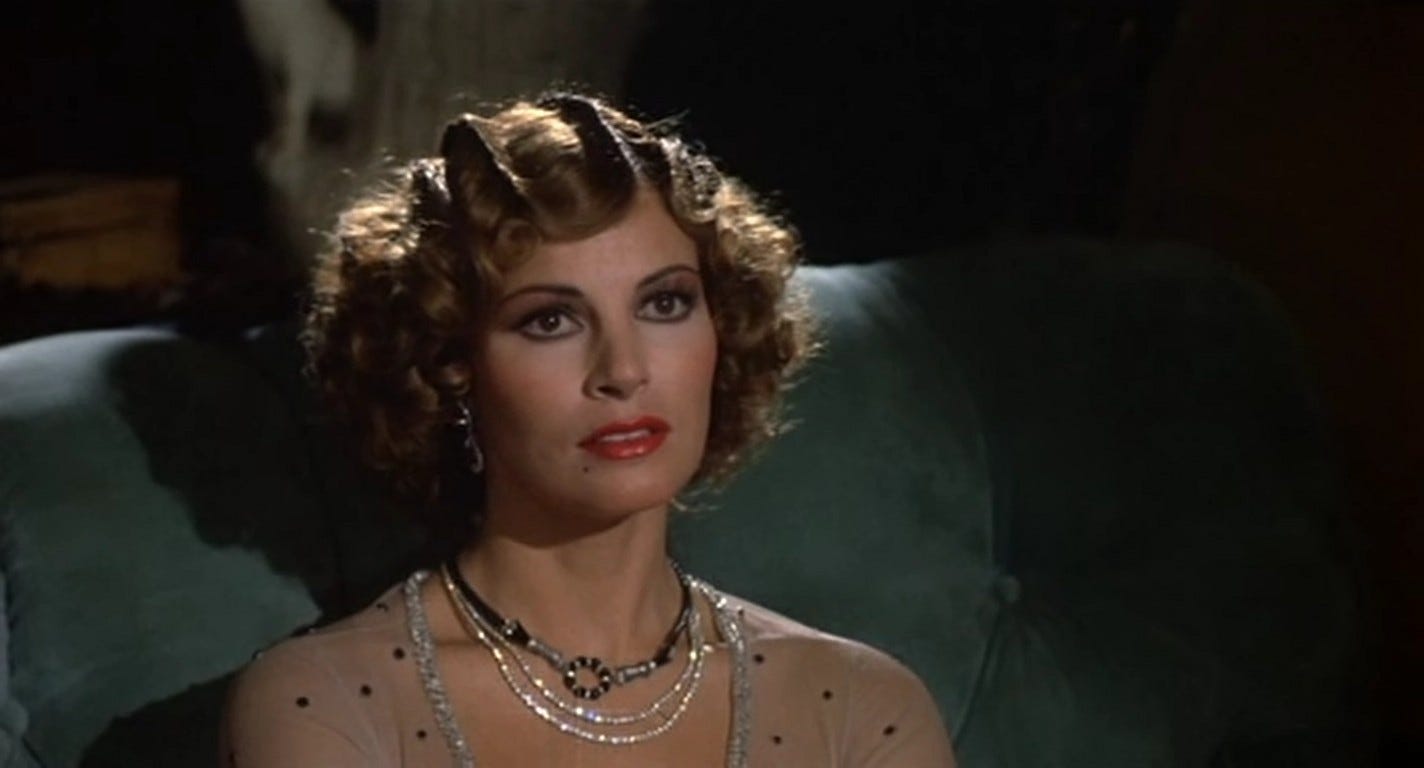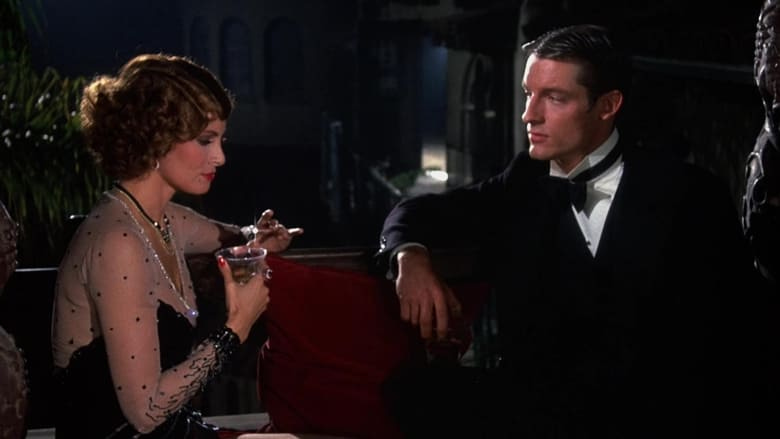“You’re Supposed to Look Good. That’s All.”: When Raquel Welch Met Merchant-Ivory
Welch’s movie career was powered by a desire to be taken seriously as more than a sex symbol. The 1975 film ‘The Wild Party’ proved how difficult that would be, on screen and off.
When Raquel Welch died last week at the age of 82, almost every obituary led with the fur bikini. Even if you haven’t seen the (pretty fun) Hammer-produced 1966 prehistoric fantasy film One Million Years B.C., you know the image: Welch looks intensely at some unseen object on the far horizon wearing a doeskin two-piece. It was the pin-up poster for the second half of the 1960s. (It even serves as the final poster used to disguise the escape tunnel in The Shawshank Redemption.) It made Welch inescapable and she never escaped it.
Not that she didn’t try to put some respectful distance between herself and that iconic image. Welch wanted to be taken seriously as an actress but also understood that she could never not be a bombshell. Her post-pinup filmography is filled with attempts to be both at once, burnishing the sex symbol image while also delivering real performances. It didn’t always work, but alongside notorious efforts like Myra Breckenridge, you’ll find Richard Lester’s The Three Musketeers and its sequel, in which Welch displays strong comic skills, and Kansas City Bomber, a solid roller derby movie delayed when Welch broke her wrist filming an action scene.
This wasn’t the first bone Welch broke on the job. She fractured her arm making Raquel!, a 1970 special for CBS designed to showcase Welch as a total entertainer who just happened to be easy on the eyes. “There’s more to me than that rinky-dink sex goddess,” Welch told The Miami Herald ahead of the premiere of the special, produced by Welch and her then-husband/manager Patrick Curtis. “But we couldn’t tell other people what we meant. So we did it ourselves.”
To prove the point, Raquel! features Welch clad in Bob Mackie-designed costumes as she sings and dances in Paris, London, the Yucatan and other far-flung locales in sequences built around her performances of “California Dreaming,” (shot largely in Paris but interrupted by a spacey, nearly three-minute aside in which Welch wears a Barbarella-inspired outfit) in“Everybody’s Talkin’” (edited to include interview clips and scenes of Welch’s life as a celebrity) and “Aquarius / Let the Sunshine In” (filmed at a pyramid in Mexico and accompanied by dancers in traditional Mayan costumes).
The hard-to-miss agenda of the special, beyond entertaining CBS viewers for an hour: Welch could do it all and look great doing it. Guests like Tom Jones, John Wayne, and a cowboy hat-clad Bob Hope also make appearances, the latter for a corny take on the Beatles’ “Rocky Raccoon” prefaced by some comments about Welch’s “them thar parts.” If she was going to be leered at, the logic seemed to go, it may as well be on her own terms and from the best leerer in the business.
Welch worked steadily. In the process, she picked up a reputation for being difficult. After co-starring alongside her in The Last of Sheila, James Mason called her “the most selfish, ill mannered and inconsiderate actress I’ve ever had the displeasure of working with.” But as with all stories of “difficult” actresses, it’s probably best not to accept a statement like that as the final word. At least part of Welch’s reputation comes from James Ivory, her director on the 1975 film The Wild Party, which contains one of the best performances of her career — not that many saw it at the time or were quick to give Welch credit if they did.
“From nearly the first day we were at loggerheads and no professional relationship, no working relationship was ever established,” Ivory wrote in “Raquel Welch: Star vs. Actress,” a 1978 essay reprinted in his 2021 memoir Solid Ivory. And, to be fair, he makes working with Welch sound tough. He describes Welch’s arrival preceded by a full retinue of support staff, including an acting coach who advised her on which takes he thought were best, and having to convey any suggestion via co-star James Coco, the only person on the set Welch respected, in Ivory’s recollection. “Sometimes when I looked into Raquel’s eyes,” Ivory continued, “nothing came back from them; I couldn’t make contact. But at other times what I saw there was a look of real suffering, so that I wanted to do anything I could to help her.”
Yet Ivory’s own recollections of the experience suggest he was hardly without blame for his star’s unhappiness. When called upon to do a love scene with Perry King, Welch offered a suggestive variation in which she would remove her jewelry as a prelude to sex that would eliminate the need even to see the characters getting into bed together. This did not go over well with Ivory or King, who told the director that, in Ivory’s words, “in the first take he planned to pin her down violently on the bed and hold her there until she threw him off.” Ivory gave the thumbs up, King did as he said he would do, and the bed collapsed because he used so much force throwing his co-star on it. Enraged, Welch refused to do a second take, which Ivory found ridiculous, just as he found the apology he was forced to offer his star “comical.”
The scene didn’t make the film’s final cut, or at least the cut Ivory created before having the film taken out of his hands by distributor American International Pictures. (And yes, it’s truly an odd project that could bring Welch, James Ivory and Ismail Merchant, and AIP, best known for providing drive-in fodder since the 1950s.) That version played a few markets in 1975, but the film wouldn’t even open in New York until the fall of 1981, and then only as part of a retrospective of Merchant-Ivory films mounted a few years before the team became synonymous for stately, thoughtful literary adaptations like A Room with a View and Howards End.
In the end, Ivory’s vision prevailed. It’s the version released on DVD in the ’00s and the one currently available to stream. Loosely adapted from a narrative poem by Joseph Moncure March (which would later be turned into a pair of musicals in the 1990s), it’s no lost masterpiece, never finding the way to spin a compelling narrative out of a fascinating milieu. But it does feature fine performances from Coco and Welch as, respectively, a silent movie comic modeled after Roscoe “Fatty” Arbuckle and his long-suffering mistress.
Welch plays Queenie, once a starving extra who’s been living a life of luxury since she was taken in by Jolly Grimm (Coco). But the temperamental Grimm’s mood swings have turned wilder than ever as his career has flailed and Queenie has been charged with making sure a party built around a screening of his would-be comeback vehicle—a silent comedy made as Hollywood begins to turn to sound—goes smoothly. That Grimm has left her with a nasty bruise on her cheek doesn't make her job any easier.
Welch expertly plays Queenie’s contradictions and mixed emotions. Queenie keeps a smile on her face in public but rages at Grimm behind closed doors. Asked why she stays with him, she recalls the good times and how little she used to have before she met Grimm. When she cheats on him with up-and-coming star Dale Sword (King), it’s both an act of defiance and the inevitable result of years of bottled-up need. “You’re supposed to look good. That’s all,” Grimm tells her, never mind how much he now owes her for keeping his life from falling apart (at least until now), an accomplishment beauty alone could never pull off.
It’s a richer part than Welch usually got to play, but she most likely didn’t have to look too far for inspiration. Hollywood may have changed between the ’20s and the ’70s, but it didn’t change that much. Welch undoubtedly understood the part of a woman who could work hard and still have her accomplishments reduced to an assessment of her looks.
Even a perceptive artist like Ivory could seemingly get her without really getting her. “It is as if she feels that the route she took to get [to success]—by becoming a movie star sex goddess, half Rita Hayworth, half Mae West—isn’t dignified enough for her so she must search for ‘serious’ parts and for directors who will take her seriously.” But maybe, the rest of the essay suggests, not that seriously, no matter how hard she tried or how well she did, or how many years, movies, TV specials, songs, and broken bones separated her present from that fur bikini in her past.







Side note but I really do appreciate that it's becoming more common to point out that a lot of directors treated actresses poorly in the name of making art, and to take that at least a little seriously. I still love The Birds, for example, but not so much that Tippi Hedren deserved what Hitchcock put her through, on that set and later.
Stella Stevens also died recently and was similarly bitterly disappointed over the years about her inability to get out the bombshell box that Hollywood put her in at the start of her career. And I agree, I don't think Hollywood's transactional treatment of women has improved much from the '20s to the '70s -- or to the '20s again. I haven't read the essay, but that icky anecdote about the choreography that Perry King cooked up for his "love scene" with Welch -- I'm inferring this was all a surprise to Welch (a la the "butter scene" from LAST TANGO IN PARIS")? It's a brutal business, and any epitaph about Welch's screen career should also include her successful lawsuit against MGM for getting fired from CANNERY ROW. She won the battle but lost the war ... and never had a major role in a movie again.